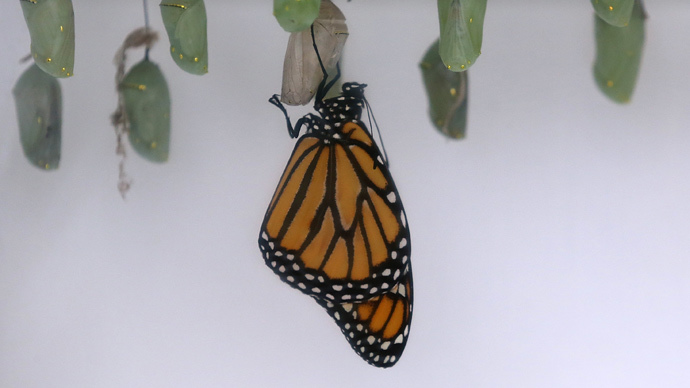Monarch butterfly may be listed as endangered species after 90% population drop

The US government may add the Monarch butterfly to the Endangered Species list following a catastrophic loss of its population over last decades due to habitat decrease from cultivation of genetically engineered crops and climate change.
US Fish and Wildlife Service announced on Monday it would conduct
a one-year status review of the Monarch butterfly to determine if
they are warranted protection under the Endangered Species Act.
The agency is requesting scientific and commercial data through a
60-day public information period and they’re looking for data on
the insects’ biology, range and population trends, habitat
requirements, genetics and taxonomy, distribution patterns,
population levels, life history, thermos-tolerance, and
conservation methods.
READ
MORE: Monsanto blamed for disappearance of monarch
butterflies
The Center for Biological Diversity said the population has
declined from a recorded high of approximately one billion
Monarch butterflies in the mid-1990s to only 35 million
butterflies last winter, the lowest number ever recorded.
The agency review comes in response to a petition from the Center
for Biological Diversity, the Center for Food Safety, and the
Xerces Society for Invertebrate Conservation to list the
subspecies of monarch (Danaus plexippus plexippus), who argue
might be necessary.
The Center for Biological Diversity said the decline is driven in
part to the widespread planting of genetically engineered crops
in the Midwest, where most Monarchs are born. The vast majority
of genetically engineered crops are made to be resistant to
Monsanto's Roundup herbicide, a potent killer of milkweed, the
monarch caterpillar's only food.
In addition to herbicide use they say Monarchs are also
threatened by global climate change, drought and heat waves,
other pesticides, urban sprawl and logging on their Mexican
wintering grounds. Scientists have predicted that the Monarch's
entire winter range in Mexico and large parts of its summer range
in the states could become unsuitable due to these threats.
Should they do it? "U.S. Government Could Grant Monarch Butterflies Protected Status" http://t.co/NZ0DbS1h2i@USFWSHQpic.twitter.com/lNRlbFnafo
— Planet Experts (@PlanetExperts) December 31, 2014
Quite apart from their obvious beauty and appeal for Lepidopterists, the Monarch butterfly or the Danaus plexippus plexippus play an important role in ecology. They pollinate or specifically they carry pollen from plant to plant helping fruit, vegetables and flowers to produce new seeds. In the food chain in their caterpillar stage they are a food source for birds, mammals and other insects.
Monarch butterflies are found throughout the United States and many fly between the US, Mexico and Canada – a journey of 3,000 miles. The journey, according to studies, has become more perilous for the butterflies because of threats along their migratory paths, their breeding grounds and wintering grounds.
"We are extremely pleased that the federal agency in charge of protecting our nation's wildlife has recognized the dire situation of the Monarch," said Sarina Jepsen, the Xerces Society's endangered species director. "Protection as a threatened species will enable extensive monarch habitat recovery on both public and private lands."












